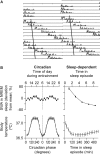Regulation and functional correlates of slow wave sleep
- PMID: 19998869
- PMCID: PMC2824213
Regulation and functional correlates of slow wave sleep
Figures






Similar articles
-
"White paper" on sleep and aging.J Am Geriatr Soc. 1982 Jan;30(1):25-50. doi: 10.1111/j.1532-5415.1982.tb03700.x. J Am Geriatr Soc. 1982. PMID: 7035529 Review. No abstract available.
-
Sleep and aging.Sleep. 1980;3(2):1-220. Sleep. 1980. PMID: 7010506 Review. No abstract available.
-
Hypnotics and sleep physiology: a consensus report. European Sleep Research Society, Committee on Hypnotics and Sleep Physiology.Eur Arch Psychiatry Clin Neurosci. 1991;241(1):13-21. doi: 10.1007/BF02193749. Eur Arch Psychiatry Clin Neurosci. 1991. PMID: 1679666 Review.
-
Napping predicts responsiveness to hypnotics in patients with primary circadian rhythm disorder.Psychiatry Clin Neurosci. 2002 Jun;56(3):231-2. doi: 10.1046/j.1440-1819.2002.00987.x. Psychiatry Clin Neurosci. 2002. PMID: 12047571
-
Dynamics of slow-wave activity and spindle frequency activity in the human sleep EEG: effect of midazolam and zopiclone.Neuropsychopharmacology. 1994 Dec;11(4):237-44. doi: 10.1038/sj.npp.1380110. Neuropsychopharmacology. 1994. PMID: 7857498 Clinical Trial.
Cited by
-
EEG Changes across Multiple Nights of Sleep Restriction and Recovery in Adolescents: The Need for Sleep Study.Sleep. 2016 Jun 1;39(6):1233-40. doi: 10.5665/sleep.5840. Sleep. 2016. PMID: 27091536 Free PMC article. Clinical Trial.
-
Sex differences in the circadian regulation of sleep and waking cognition in humans.Proc Natl Acad Sci U S A. 2016 May 10;113(19):E2730-9. doi: 10.1073/pnas.1521637113. Epub 2016 Apr 18. Proc Natl Acad Sci U S A. 2016. PMID: 27091961 Free PMC article.
-
Sleep Characteristics in Esport Players and Associations With Game Performance: Residual Dynamic Structural Equation Modeling.Front Sports Act Living. 2022 Jan 13;3:697535. doi: 10.3389/fspor.2021.697535. eCollection 2021. Front Sports Act Living. 2022. PMID: 35098116 Free PMC article.
-
Interactions between Sleep and Emotions in Humans and Animal Models.Medicina (Kaunas). 2022 Feb 11;58(2):274. doi: 10.3390/medicina58020274. Medicina (Kaunas). 2022. PMID: 35208598 Free PMC article. Review.
-
Racial disparities in sleep-related cardiac function in young, healthy adults: implications for cardiovascular-related health.Sleep. 2021 Nov 12;44(11):zsab164. doi: 10.1093/sleep/zsab164. Sleep. 2021. PMID: 34214173 Free PMC article.
References
-
- Bonnet MH. Sleep restoration as a function of periodic awakening, movement, or electroencephalographic change. Sleep. 1987;10:364–73. - PubMed
-
- Akerstedt T, Hume K, Minors D, Waterhouse J. Good sleep–its timing and physiological sleep characteristics. J Sleep Res. 1997;6:221–9. - PubMed
-
- Dijk DJ, Groeger J, Deacon S, Stanley N. Association between individual differences in slow wave sleep, slow wave activity and sleep continuity in young, middle-aged and older men and women. Eur Neuropsychopharmacol. 2006;16:S538.
-
- Ohayon MM, Carskadon MA, Guilleminault C, Vitiello MV. Meta-analysis of quantitative sleep parameters from childhood to old age in healthy individuals: developing normative sleep values across the human lifespan. Sleep. 2004;27:1255–73. - PubMed
-
- Rechtschaffen A, Kales A. A manual of standardized terminology, techniques and scoring system for sleep stages of human subjects. Washington, DC: Public Health Service, US Government Printing Office; 1968. - PubMed
Publication types
MeSH terms
Substances
Grants and funding
LinkOut - more resources
Full Text Sources
Other Literature Sources
